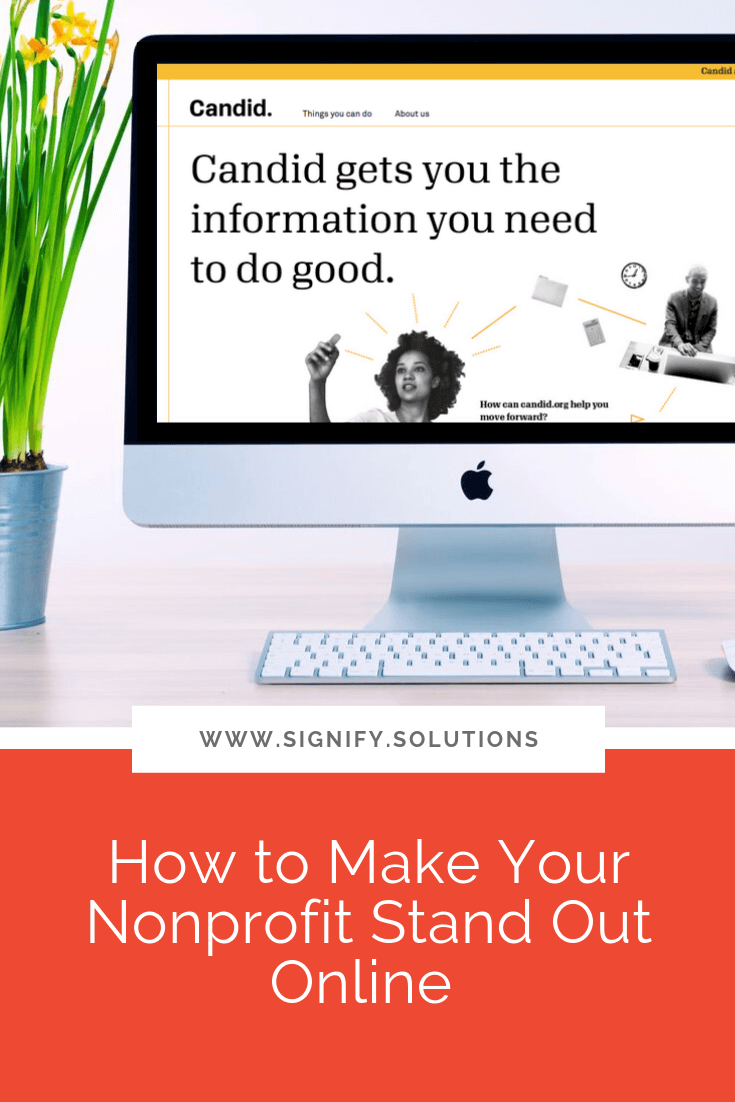We’re headed into the final weeks of the year, which means nonprofit fundraising is in overdrive. About 30% of nonprofit donations occur during the month of December, so yes—it’s go time! And whether you’re late to the party or have been planning for months, I know you’re all about maximizing your time and effort. So, I’ve outlined 11 simple ways to improve your year-end giving campaign.
Notice I said “simple,” not “easy,” because we all know there’s a big difference! Simple is focused, minimal, or straight-forward. Easy is typically done in a short time period and with little work.
Simple is Joanna Gaines decorating a room effortlessly and beautifully because it’s what she does every day. Easy is me picking up her decor at Target rather than me trying to design a room on my own. (Thanks, Jo!)
So, while some of these ideas take more energy and planning than others, all are time-tested and proven to help increase your donations. Think about what you’ve already got planned, and then take a peek below to see what you can include in your upcoming fundraising campaign. It’s likely that at least one of these ideas can enhance your current strategy.
People are feeling charitable (and tax-deductible) this time of year, so let’s make sure your cause gets their attention.
1. Ask For Only One Thing in your year-end giving campaign
Chances are, you’re going to be asking for donations. If that’s the case, ask your tribe to show you the money.
Don’t also ask them to follow you on social media, watch an unrelated video, join your Facebook Group, register for something . . . and, well, you get the point. Keep your emails and communication focused on the one, main thing you want them to do. Any other asks can come later. The exceptions to this rule would be something like a contest where they have to take multiple actions for an entry.
Additionally, you can leave some of these smaller asks such as social media links in secondary spaces like footers. You can also still make some of these requests occasionally on your platforms. Just be sure that you’re creating more content than you are asking for something because it shows that you want to build a relationship.
However, when you are sending an email, posting about your year-end giving campaign, or presenting to a group of people, keep it simple. Ask for only one thing and don’t clutter your message.
Remember, Nonprofits Source says that “30% of annual giving occurs in December.” So, this is no time to confuse people on what you want them to do! Giving them too many options or actions may result in them taking no action at all. Yikes.
2. Evaluate Your NONPROFIT’S Website For Optimal Giving
Even if people typically donate to your nonprofit through social media, text, or an app, you need get your website’s house in order to optimize year-end giving. Many people still give through websites, and if someone is new to you or your cause, they may check out your site before donating through another avenue like texting.
Make sure your campaign is front-and-center on your homepage, your donate button is easy to see and ideally in the top right corner, and evaluate any other pages where giving should be mentioned.
No need to only designate one or two pages for fundraising efforts. Of course, you don’t want to bombard people, but it may be appropriate to create an “event” for your campaign on your calendar page, add a pop up, or even include it on your About page. Additionally, you can create a banner at the top of your site that will display on all pages. (See mine in red at the top?) This is done through the “Hello Bar” plug-in on Wordpress and the “Announcement Bar” in Squarespace.
Want more of an explanation? Take a look at my video on how your website is less like IKEA and more like a mall.
3. Increase Your Promotion Frequency
There’s a tricky balance to this, and I explain it more in this video, but you definitely want to increase your email/social media/video/promotion frequency leading into year-end giving. This practice holds true anytime you launch something new, but especially because you’ll be dealing with a lot of competition during the holidays. Other nonprofits will be combing the interwebs for more donations, too, and lest we forget about all of those unbelievable sales at your favorite retail stores.
The takeaway here is that you shouldn’t send an email in November and December, post the campaign on social media a couple of times, and call it a day. You are going to have to work hard for that money, as the song goes. And you’re going to have to see it through until the end. Give Back Nation states that 12% of annual giving occurs during the last three days of December! So, send those reminders!
The caveat here is for my friends who’ve been so busy working that they let all their marketing and communications efforts fall by the wayside. Is that you? No judgement, but now’s the time to rev up those engines. Start now by sending your audience an email on what’s been happening, posting the latest on social media, and having general update conversations with people. This way you aren’t only going to send them a bunch of requests for money. That’s no bueno.
4. Offer Multiple Ways to Give to your nonprofit
Give your people multiple ways to give. This goes back to the basics of knowing your audience. If you have a younger audience, consider adding the ability to donate via text. Check out these compelling stats from Mobile Cause, including the one that says, “96% of donors use a mobile phone as their primary device.”
If you have an older audience, you might want to consider hopping back on the snail mail wagon. There is no perfect answer here. The right answer is the one that works for your tribe.
Again, you always want to make it easy for them to donate by removing any barriers in their path.
5. Add a Bonus
If you’ve got merchandise on your hands, you may want to give donors a gift in exchange for their contribution. You could even have something created just for this purpose, like a mug, tumbler, t-shirt, or jewelry. What do your people love?
People who are invested in your organization and your cause will be delighted to receive swag for their support. Plus, then they’re carrying your message around with them in public. (<— good marketing!)
6. Get Up Close and Personal with your donors
I don’t need to go in-depth on this one, but a face-to-face interaction will always be your best bet when it comes to fundraising. It works better than any sponsor presentation, email, video, or social media post. Get on the calendar of your biggest donors to date, or potential big givers, and make your case over lunch or coffee. Maybe even pay for it!
Another option here is to at least email people personally and start a conversation. Don’t rely on the mass emails that come from your nonprofit. Write specifically to that one person, and make sure they know it’s coming straight from you. (For the right people, phone calls or video chats are also a good option here.)
Don’t have time? This is potentially the most powerful of all the ideas you’ll read here today, so if you don’t have time, I suggest you make it.
7. Get Everyone on Board
Year-end fundraising is an all hands on deck situation! Make sure your board, employees, volunteers, and any other key stakeholders are carrying the banner.
I talk about this topic a lot on the blog and elsewhere as it relates to launching (<— the creation and promotion of something new), but this is a big deal, so it shouldn’t be left to the development or communications department. Everyone needs to be involved!
(For more on this topic, read this post.)
8. Go Out and network
Yes, it’s getting chilly outside, but this may be the prime time to get out there and start cultivating more donors at events, whether you’re hosting them or not. There’s already plenty happening this season!
It’s easy to leave all of the fundraising to your digital marketing strategy, but shaking hands has a powerful impact on people. In fact, this study shows that “a handshake preceding social interaction enhanced the positive impact of approach and diminished the negative impact of avoidance behavior on the evaluation of social interaction.”
A handshake and a smile can put people at ease, and give you an open door for talking about your cause. Someone may not be ready to donate during that first interaction, but you’re paving the way to a future relationship, which is a big win overall.
9. Participate in #GivingTuesday (At Least to Some Extent)
Some of you probably love #GivingTuesday, and some of you could care less. Some of you may even be new to the “holiday” as a whole, since it’s been around less than a decade.
Now in its eighth year, this unofficial holiday occurs the Tuesday after Thanksgiving, and celebrates ways people can contribute to causes, whether monetary, through volunteering, or some other type of involvement.
A few of my clients have participated in #GivingTuesday in the past, but most haven’t. What I suggest to them all, however, is to jump into the mix in some way or another. There are tens of thousands of charities participating each year, so why not be a part of the conversation?
You don’t have to come up with a specific #GivingTuesday campaign, but I think it’s a great idea to send an email on this day or the day before, post on social media about your year-end fundraising campaign, and anything else that keeps you in front of your audience while numerous other nonprofits are out there seeking donations.
Even the most generous of us still only have so much money to go around, so make sure you’re getting a piece of that pie.
10. Ask Partners to Promote your year-end giving campaign
If you are lucky enough to have influencers, partners, sponsors, and the like who rally around your cause, it may be time to call in a favor. You may, of course, need to do something for them in return (or at least offer), but if there’s someone who can help you get your message out in the world, this could be a great time to rally the troops.
Let me sing my song again, though: Make it easy for them. Don’t just say thanks, and leave them to put together their own social media promotions and emails. It’s less likely to get done, or the messaging may not be what you want.
Always offer to create whatever resources they may need to share about your nonprofit. If they don’t need anything, great! But if they do, you’ll be the hero!
11. Recruit Someone to Match Gifts
I’ve left this one for last because it’s potentially the hardest. In fact, because we’re already in November, it may even be too late. But depending on your network and resources, maybe not! I’d certainly give it a try. If it’s an option you need to table for now, make it one of your top priorities for next year.
And let me clarify. This idea could include workplace charitable giving with a matching option, or one of those, “Give by December 15th and all donations will be matched up to $50,000” kind of campaigns that is instigated by one generous donor.
According to Double the Donation, “Mentioning matching gifts in fundraising appeals results in a 71% increase in the response rate and a 51% increase in the average donation amount (and that’s prior to receiving matching gift funds).” That stat makes it a big deal!
So, determine your heavy-hitters as well as your corporate partners, and see what it will take to move the needle in your direction. This could be a huge win for your nonprofit!
What else has helped you haul in those end of year donations?
PIN THIS POST FOR LATER:
I’m Kristi Porter, and I help cause-focused organizations understand and execute effective marketing campaigns so they can move from stressed to strategic. Your resources may be limited, but your potential isn’t. Whether you’re a nonprofit, social enterprise, or small business who wants to give back, I’ll show you how to have a bigger impact.














































